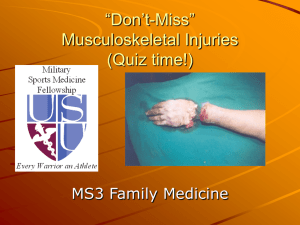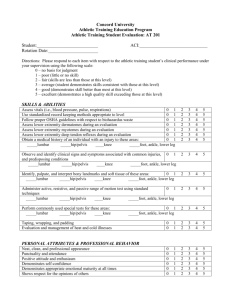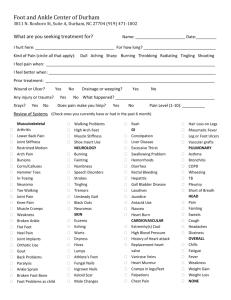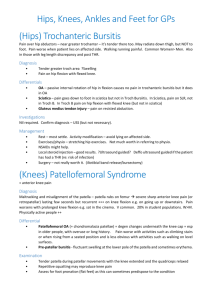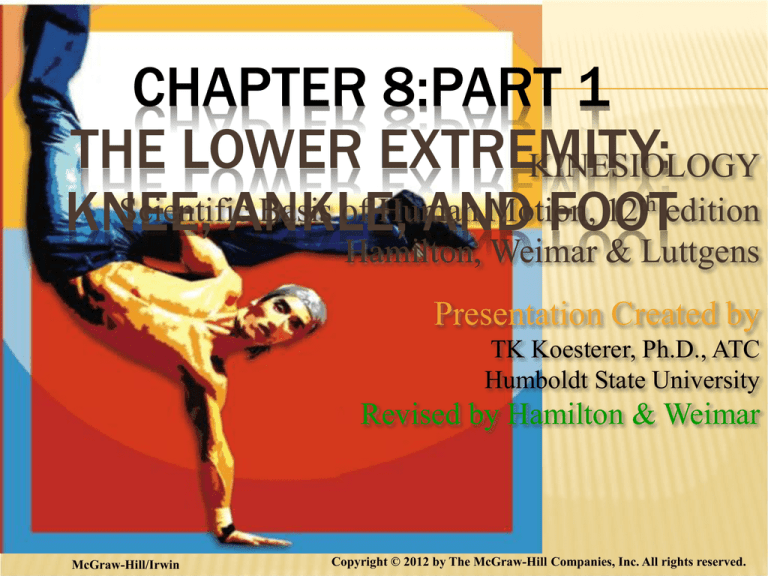
CHAPTER 8:PART 1
THE LOWER EXTREMITY:
KINESIOLOGY
Scientific
Basis of Human
Motion,
12 edition
KNEE,
ANKLE,
AND
FOOT
th
Hamilton, Weimar & Luttgens
Presentation Created by
TK Koesterer, Ph.D., ATC
Humboldt State University
Revised by Hamilton & Weimar
McGraw-Hill/Irwin
Copyright © 2012 by The McGraw-Hill Companies, Inc. All rights reserved.
OBJECTIVES
1. Name, locate, & describe the structure & ligamentous
reinforcements of the joints of the knee, ankle, and
foot.
2. Name & demonstrate movements possible.
3. Name & locate muscles & muscle groups, and name
their primary actions.
4. Analyze the fundamental movements with respect to
joint & muscle actions.
5. Describe common athletic injuries.
8-2
THE KNEE JOINT: STRUCTURE
Hinge joint.
Two condyles of femur
articulate with tibial plateaus.
Patella articulates with
patellar surface of femur.
Fig 8.2
Menisci
Circular rims of fibrocartilage.
Lateral –an incomplete circle.
Medial – “C” shaped.
Thick peripheral borders,
tapering to a thin inner edge.
Fig 8.4
8-3
LIGAMENTS OF THE KNEE
Lateral
Lateral
Medial
Fig 8.3
8-4
LIGAMENTS OF THE KNEE
Lateral
Medial
Fig 8.6
Fig 8.5
8-5
MUSCLES OF THE KNEE JOINT
Anterior
Quadriceps Group
Rectus femoris
Vastus intermedius
Vastus lateralis
Vastus medialis
Posterior
Hamstring Group
Biceps femoris
Semimembranosus
Semitendinosus
Sartorius
Gracilis
Popliteus
Gastrocnemius
8-6
MUSCLES OF THE KNEE JOINT
Rectus Femoris
Function:
Powerful knee extensor.
Sartorius
Function:
Flexion and internal
rotation in non-weight
bearing.
Fig 8.7
8-7
MUSCLES OF THE KNEE JOINT
Vastus intermedius
Vastus lateralis
Vastus medialis
Function:
Powerful knee
extensors.
Fig 8.8
8-8
MUSCLES OF THE KNEE JOINT
Biceps femoris
Function:
• Flexes knee & external
rotation of tibia in non-weight
bearing.
Semimembranosus
Semitendinosus
Function:
• Flexion and internal rotation
in non-weight bearing.
Fig 8.10
8-9
MUSCLES OF THE KNEE JOINT
Gracilis
Function:
• Flexes knee.
• Slightly active in internal
rotation of tibia when knee is
flexed.
Popliteus
Function:
• Helps flex knee (unlocks).
• Internally rotates tibia.
Fig 8.11
8-10
MUSCLES OF THE KNEE JOINT
Gastrocnemius
Function:
• Helps flex knee.
• In weight bearing can
help maintain knee
extension.
Fig 8.23
8-11
MUSCULAR ANALYSIS OF FUNDAMENTAL
MOVEMENTS OF THE LEG AT THE KNEE JOINT
Flexion: Hamstrings, sartorius, gracilis
Extension: Quadriceps
External Rotation: Biceps femoris
Can
only occur when knee is flexed & non-weight
bearing.
Internal Rotation: Semimembranosus,
semitendinosus, popliteus
Can
only occur when knee is flexed & non-weight
bearing.
8-12
COMMON INJURIES OF THE LEG, KNEE AND
ANKLE
The Leg: Tibial Stress Injuries
Often called “shin splints”.
An overuse injury.
Repeated microtears where tibialis posterior or
anterior attaches to tibia, inflammation.
Sprains in interosseous membrane.
Tenderness & pain on medial surface of tibia.
Rest, softer surface and supporting the arch are
best treatment.
8-13
COMMON INJURIES OF THE LEG, KNEE AND
ANKLE
The Leg: Fracture
Most common among the young.
Most common to lower 2/3 of fibula.
May result in instability of ankle joint.
Severity based on bone displacement:
More displaced - more severe.
The Leg: Shin Contusions
Common based on exposed nature of tibia.
Usually from a direct blow.
May damage periosteum.
Shin guards are recommended in activities in which leg
impacts are common.
8-14
COMMON INJURIES OF THE LEG, KNEE AND
ANKLE
The Knee: Collateral Ligament Sprain
Direct blow to either side of knee.
Majority are blows from lateral side causing medial collateral
ligament damage.
Depending on amount of force the following structures could be
injured:
Medial collateral ligament
Medial meniscus
Anterior cruciate ligament
The Knee: Chondromalacia
Degeneration of cartilage on articulating surface of patella.
Pain, on movement, swelling, grating sensation.
Treatment through evaluation of lower body biomechanics,
rehabilitative exercises, limiting activities.
8-15
COMMON INJURIES OF THE LEG, KNEE AND
ANKLE
The Knee: Osgood Schlatter Disease
Due to repeated overuse of knee
extensors.
Tearing or avulsion of epiphysis of tibial
tuberosity.
Swelling, pain on activity & kneeling.
Treat with rest, ice, rehabilitative
exercises.
8-16
THE ANKLE AND FOOT:
The foot provides for support and propulsion.
Movements within the foot occur primarily at
the subtalar and midtarsal joints.
The ankle serves to unite the foot and the
leg.
8-17
STRUCTURE OF THE ANKLE
Hinge joint
Articulation of talus
with malleoli of
tibia & fibula.
Bound together by
ligaments.
Tibia
Fibula
Talus
Sustentaculum
tali
Calcaneous
Fig 8.12
8-18
LIGAMENTOUS REINFORCEMENT
Lateral side
Anterior talofibular
Calcaneofibular
Posterior talofibular
Medial side
Deltoid
Calcaneotibial
Anterior talotibial
Tibionavicular
Posterior talotibial
Plantar calcaneonavicular
Fig 8.14
Deltoid
a. Calcaneotibial
d. Posterior
talotibial
b. Anterior talotibial
c. Tibionavicular
Fig 8.13
Plantar calcaneonavicular
8-19
STRUCTURE OF THE FOOT
An elastic arched
structure.
Talus
is the keystone.
Comprised of two
arches:
Longitudinal
Transverse
Fig 8.15
8-20
STRUCTURE OF THE FOOT
Longitudinal arch:
Heel to heads of five
metatarsals.
Supported by the plantar
fascia.
Transverse arch:
Side-to-side concavity.
Anterior tarsal bones &
metatarsals.
Fig 8.16
8-21
SUBTALAR JOINT
Joint between underside of talus and upper
& anterior aspects of calcaneus.
Plantar calcaneonavicular “spring ligament”
helps support talus.
Fig 8.17b
8-22
FOOT JOINTS
Midtarsal Joint (Chopart’s Joint): Consists of two
articulations:
Calcaneocuboid: Nonaxial – permits only gliding.
Talonavicular: Modified ball-and-socket – permits restricted
motion.
Tarsometatarsal Joints: Movements are gliding.
Intermetatarsal Joints: spreading or flattening.
Metatarsophalangeal Joints: Modified condyloid joints.
Interphalangeal Joints: Hinge joints.
8-23
MOVEMENTS OF FOOT AT THE ANKLE, TARSAL, &
TOE JOINTS
Fig 8.20
8-24
MUSCLES OF THE ANKLE & FOOT
Location:
22 muscle of the ankle & foot are intrinsic.
11 muscles are extrinsic.
8-25
MUSCLES OF THE ANKLE & FOOT
Tibialis Anterior
Function: dorsiflexes ankle &
supinates foot.
Peroneus Brevis
Function: plantarflexes, everts.
Extensor Hallucis Longus
Extensor Hallucis Brevis
Function: extends great toe.
Extensor Digitorum Brevis
Function: extends toes.
Fig 8.21a
8-26
MUSCLES OF THE ANKLE & FOOT
Extensor Digitorum
Longus
Function: extends toes.
Peroneus Longus
plantarflexes,
everts, abducts.
Peroneus Tertius
Function: dorsiflexes &
pronates.
Fig 8.22
8-27
MUSCLES OF THE ANKLE & FOOT
Gastrocnemius
Function: powerful plantar flexor.
Fast twitch.
Allows one to rise on toes, lift
body weight.
Advantageous leverage.
Fig 8.23
8-28
MUSCLES OF THE ANKLE & FOOT
Soleus
Function: Strong ankle plantar flexor.
Slow twitch.
Postural, static plantar flexion.
Fig 8.24
8-29
MUSCLES OF THE ANKLE & FOOT
Tibialis Posterior
Function: plantar flexes tarsal
joints, supination when foot is
plantar flexed.
Helps holds up longitudinal
arch.
Fig 8.25
8-30
MUSCLES OF THE ANKLE & FOOT
Flexor Digitorum Longus
Function: Flexes toes, plantar
flexes, helps inversion.
Flexor Hallucis Longus
Function: flexes great toe, plantar
flexes, helps inversion.
Fig 8.26
8-31
INTRINSIC MUSCLES OF THE FOOT
Fig 8.27 & 8.28
8-32
INTRINSIC MUSCLES OF THE FOOT
Fig 8.29 & 8.30
8-33
MUSCULAR ANALYSIS OF FUNDAMENTAL
MOVEMENTS: ANKLE
Dorsiflexion: tibialis anterior, peroneus tertius,
extensor digitorum longus, extensor hallucis
longus.
Plantar flexion: gastrocnemius, soleus,
peroneus.
Possible
help from tibialis posterior, peroneus
brevis, flexor digitorum longus, flexor hallucis.
8-34
MUSCULAR ANALYSIS OF FUNDAMENTAL
MOVEMENTS: TARSAL JOINTS
Dorsiflexion: same as ankle.
Plantar flexion: tibialis posterior, flexor
digitorum longus, flexor hallucis longus,
peroneus longus.
Supination: tibialis anterior (when foot is
dorsiflexed) & tibialis posterior (when foot is
plantar flexed).
Pronation: peroneus longus, brevis, & tertius.
8-35
MUSCULAR ANALYSIS OF FUNDAMENTAL
MOVEMENTS: TOES
Flexion: flexor digitorum longus and flexor
hallucis longus.
Extension: extensor digitorum longus and
extensor hallucis longus.
8-36
COMMON INJURIES OF THE LEG, KNEE AND
ANKLE
The Ankle: Strain
Due to impact that forces ankle beyond
normal range.
Results in tearing at myotendinous
junction.
May cause pain, weakness, possible
deformity. Potentially very debilitating.
8-37
COMMON INJURIES OF THE LEG, KNEE AND
ANKLE
The Ankle: Sprains
Usually associated with forceful inversion
of the foot.
In this case the lateral ligaments
stretched or torn, or may rupture.
Results in pain, swelling, disability.
8-38
COMMON INJURIES OF THE LEG, KNEE AND
ANKLE
The Ankle: Fracture
Same causes as ankle sprains.
The majority occur to malleoli.
More serious fractures sometimes
dislocate.
8-39
COMMON INJURIES OF THE LEG, KNEE AND
ANKLE
The Foot: Plantar Fasciitis
Pain and tenderness along the sole of the
foot.
May be due to inflammation, micro tears, or
rupture of the plantar fascia.
Is generally an overuse injury; lack of
flexibility may be contributory.
Stretching has been shown to be helpful.
8-40



